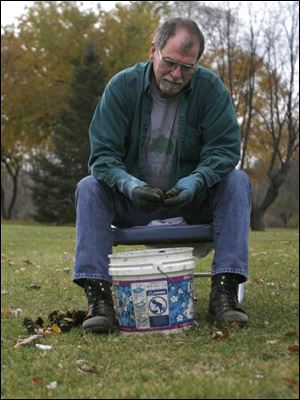
Protect your skin from walnut stains
11/16/2005Even if you have a black-walnut tree in your yard, getting a few cups of nutmeats for your banana bread can be pretty tough.
Al Kelly and his neighbor Charles Wilson have been picking up walnuts from their Lambertville trees for years. Mr. Kelly's wife, Brenda, says the men gathered about 10 five-gallon buckets full of unhulled nuts from their six trees this season.
Armed with gloves, old clothes, and eye protection, the men attacked the walnuts.

Al Kelly shells black walnuts. He and his friend Charles Wilson shelled 10 buckets of the nuts and ended up with about one five-gallon bucket of nutmeats.
"We usually wear gloves and also put rags over our hands when we take the green part off the shell," Mrs. Kelly says. "Any part of juice that gets on your skin will stain."
The thick, green, corrosive outer coat is called the epicarp and the stone, or endocarp, inside holds the nutmeat.
Dermatologist John Anders of Anders Medical Corp. of Toledo, says there isn't anything you can do to get that stain off your hands. "It sticks on your skin just like it sticks to wood," he says. "Time is the only thing that will wear the pigment off your hands."
Mr. Wilson received a first-hand lesson about black-walnut stains when he was shelling the nuts and had a small hole in one of his gloves. By the time the epicarp was removed from the walnut shells, Mr. Wilson's hands were stained black. "His hands looked like crispy critters," says Mrs. Kelly. "He went to the doctor and was given antibiotics and a shot because he had so much damage on his hands."
Mrs. Kelly says there are other techniques for removing the epicarp. "Sometimes, they put them in a bag and whack them with a hammer," she says.
Other walnut lovers put a single layer of walnuts on the ground, and place a board on top of the nuts. Standing on the board and rolling slowly from side to side will help break open the flesh without getting splashed.
Stains aren't the only problems posed by black-walnut trees. When it is really hot, a bruised walnut can give off a powerful odor that can make some people drowsy or sick. The trees' roots create a chemical called juglone. Plants around a black-walnut tree can turn brown and may die from juglone overdose. Plants like tomato, potato, blackberry, blueberry, azalea, mountain laurel, rhododendron, red pine, and apple can be injured or killed within a month or two if they are within 50 to 60 feet of a black-walnut tree's trunk.
Juglone doesn't mix with water well, so scientists say it doesn't move far in the soil. When it is in the leaves and inside the tree, it is called hydrojuglone and is considered nontoxic. When it comes into contact with air or soil, however, it turns into a toxic form. Other trees including English walnut, hickories, and pecan also produce small amounts of juglone.
After hours of smashing and cracking their 10 buckets of nuts while wearing protective gear, Mr. Kelly and Mr. Wilson ended up with about one five-gallon bucket of nutmeats. Mrs. Kelly says, "When they try my fruit salad, cookies, and candied yams at Thanksgiving dinner, they will all know it was worth it."